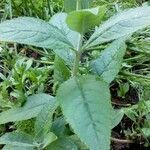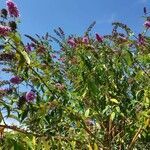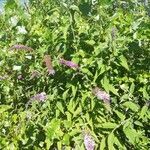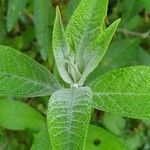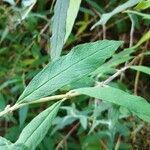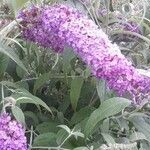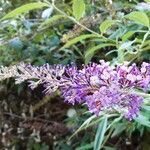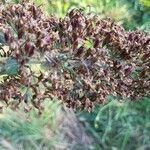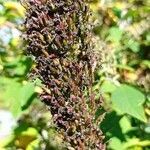Large bush up to 2.5 m. Branches subquadrangular, when young densely grey to white tomentose. Leaves oblong-elliptic or-ovate, 8-10 by 3-4 cm, herbaceous, glabrous above except on the base of the midrib, densely tomentose beneath; base cuneate, attenuate, margin minutely serrate-dentate, apex acute-acuminate; petiole c. 0.5 cm long, densely tomentose, glabrescent, at the base with auriculate, usually not connate, often relatively large stipules. Inflorescences terminal, sometimes moieover lateral, thyrsoid, composed of mostly short-stalked, lax, many-flowered cymes, c. 12-20 by 3.5 cm, sparsely pubescent. Bracts linear, up to c. 0.5 cm. Flowers subsessile, very fragrant. Calyx slender-campanulate, 3 mm long, outside sparsely pubescent, lobes c. 1/3-1/4 the total length of the calyx, acute. Corolla lilac, the mouth orange-yellow, outside glabrous, inside sparsely hairy above the insertion of the stamens, tube slender, 9 mm, slightly swollen halfway, lobes semiorbicular, 2-2.5 mm long, their margin crisped. Stamens inserted halfway the tube, anthers 1 mm long, 2-parted at base, apiculate. Pistil glabrous, style 2 mm including the club-shaped stigma. Capsule lanceolate-ellipsoid, 8 by 1.5-2 mm, glabrous. Seeds thread-like, 4 mm, in the centre only slightly thickened.
Deciduous shrub 1-3-(4) m high. Shoots obtusely angled, floccose, tomentose when young. Lvs with petiole to c. 1 cm long or sometimes subsessile just below infl. Stipules to c. 5 mm wide, broader than long. Lamina c. 6-20 × 2.5-8 cm, ovate, less commonly lanceolate, glabrous or nearly so above, whitish or greyish tomentose below, serrulate or crenulate, occasionally with coarser teeth; base cuneate; apex acuminate. Panicles c. 30 × 5 cm, elongated and broadly cylindric, composed of dense fragrant fls; branches tomentose; pedicels very short. Calyx c. 2 mm long, tomentose; teeth < tube, lanceolate. Corolla tube 7-10 mm long when fresh, mauve to purple, orange inside, hairy outside or, less commonly, glabrous; lobes 2.5-4 mm long, obovate, mauve to purple (sometimes white in cultivation). Stamens inserted 1/2-⅔ along tube; anthers sessile. Style not reaching level of stamens. Ovary glabrous or nearly so. Capsule 5-10 mm long, cylindric-obovoid, glabrous.
Corolla violet or lilac (white not seen in specimens in the field), orange–yellow within the throat, with erect lobes 3–5 times as long as the calyx, 7·5–14 mm. long, outside glabrous or stellate–pubescent and/or with minute glandular hairs; tube nearly cylindrical, 2–4 times as long as the calyx, 3–5·5 times as long as the lobes, 6–11·5 mm. long, 0·9–1·5 mm. wide below the throat and from there abruptly widened; lobes circular or slightly longer than wide, 1·3 x 1·3 mm., rounded, entire to crenate, spreading.
Leaves opposite or sometimes subopposite, shortly petiolate; stipules foliate, often only present on main branches; long; lamina narrowly ovate or narrowly elliptic, 3–6 times as long as wide, 4–20 x 1–7 cm., acuminate at the apex, cuneate at the base, serrate to subentire.
Shrubs 2–4 m; lvs lanceolate or lance-ovate, 1–2 dm, serrate, tomentose beneath; fls in slender panicles 1–2 dm; cor 1 cm, salverform, lilac with orange center; 2n=76. Native of China, escaped from cult. here and there in our range. July–Sept.
Calyx narrowly campanulate, 2–3·5 x 1–1·5 mm., outside stellate–pubescent to glabrous, tube (1·5)2–5 times as long as the lobes; lobes subequal, usually narrowly triangular, 0·5–2 x 0·5–0·8 mm., acute or acuminate, entire.
Inflorescence terminal, sometimes also lateral, thyrsoid, long and rather narrow, 10–30 x 3–5 cm., rarely smaller, composed of mostly short–stalked, lax, many–flowered cymes.
Ovary oblong or nearly so, laterally compressed, glabrous, minutely pubescent, or sometimes with glandular hairs.
Stamens included; filaments very short, mostly inserted in the middle of the corolla tube.
Branchlets subquadrangular, stellate–tomentose when young, glabrescent.
Capsule narrowly ellipsoid or narrowly ovoid, (3)5–9 x 1·2–2 mm.
Flowers all shortly pedicellate or some sessile.
Shrub 0·50–3 m. high, often sarmentose.
